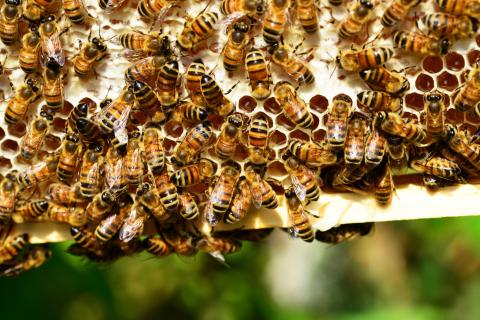Diagnosing Honey Bee Health

Global threats to honeybees have been getting more public attention lately, and there is growing awareness about how colony collapse disorder (CCD) is impacting honeybee populations, both around the world and here in New Hampshire.
Though the name may suggest a single problem, recent research has found that CCD may actually be a complication of several factors that have a cumulative effect resulting in total colony loss. We’re learning that a combination of threats such as parasites, viruses, and man-made chemicals all negatively affect the overall health of honeybees. Together, these negative influences harm bees by reducing their natural ability to fight off infections, as well as through potential chemical poisoning. This ultimately kills enough individual bees to bring the colony to a point where it can no longer support itself.
Varroa Mites
A type of parasitic mite, the Varroa mite has been identified as a primary driver of the CCD process. Varroa mites lay their eggs with bee larva. As the larva develops, so do the new mites. The mites then attach themselves to the new bee as it emerges and becomes part of the working colony, where it can spread. Varroa mites feed off the tissue of the bee and spread other viruses and diseases to the bee. Since they travel outside the hive with the bees, they can come into contact with bees from other colonies and spread to nearby hives.
Controlling the Varroa mite has become a primary responsibility for beekeepers. In fact, according to the annual Hive Loss Survey, N.H. beekeepers in 2016 who treated for Varroa had higher rates of colony survival than those that did not. NHBA Hive Loss Survey Info: http://nhbeekeepers.org/?page_id=568
Nosema
A fungal parasite, Nosema is another major threat to honeybees. Nosema was recognized in European honeybees as early as 1907 but a new, more concerning strain has emerged worldwide and has reinforced the need to study and understand this disease better.
Nosema is a microsporidium fungus that infects the gut of honeybees by attacking healthy cells, reducing digestive ability and draining the bee of valuable energy for flying, gathering pollen and nectar and supporting the health of the colony. The spores are spread through bee feces and can accumulate within hives and on comb, so managing and treating equipment are essential practices for controlling this disease.
Nosema is most accurately identified using a microscope to study the spores in the bee gut. The NH Honey Bee Diagnostic Network is a new resource that will screen for Nosema at no cost to the beekeeper. To learn more, visit www.nh-honeybee-health.com
Get Involved
We’re beginning to understand that there may be no single factor that causes a honeybee colony to collapse. Rather, it seems to be a combination of negative influences that work together to drain the health and energy of individual bees, which in turn cannot do their jobs well enough to support the larger colony, leading to the decline of the population until the colony cannot sustain itself and the remaining bees die. Learn more about how you can get involved or find resources available for N.H. beekeepers at www.nh-honeybee-health.com